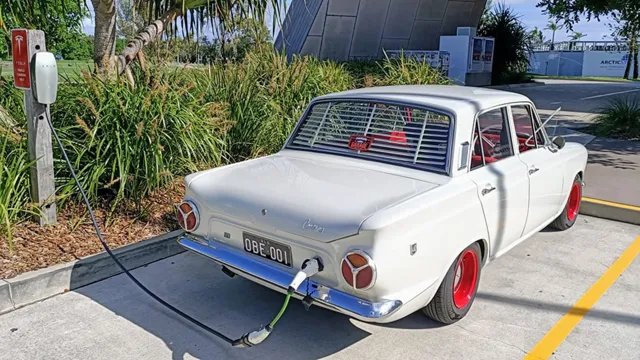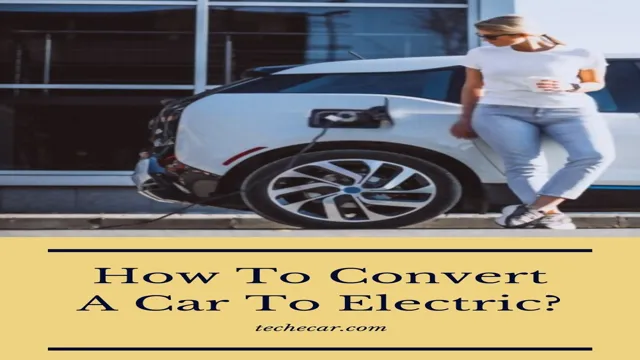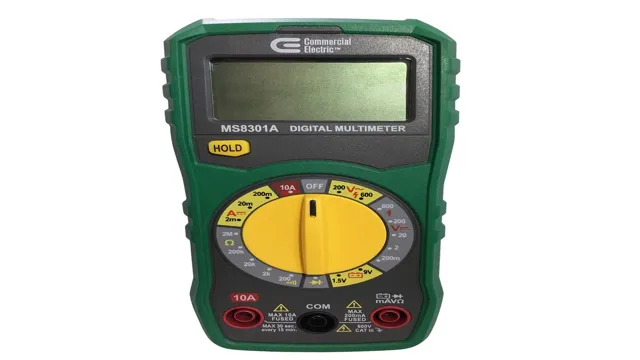Revolutionize Your Ride: The Ultimate Guide on How to Convert Your Car to Electric
Are you curious about electric cars? Do you want to make a positive impact on the environment but aren’t sure where to start? Transitioning to an electric vehicle can be overwhelming, but it doesn’t have to be. Converting Your Car to Electric: A Beginner’s Guide provides everything you need to know about converting a gas-powered car to electric. We’ll explore the basics of electric vehicles, including the differences between AC and DC motors, battery types, and charging equipment.
By the end of this guide, you’ll be equipped with the knowledge to make informed decisions about your own electric vehicle conversion project. Let’s dive in!
Why Electric
If you’re looking to reduce your carbon footprint and save money in the long run, converting your car to electric is a great option to consider. But with so many different options and components to consider, it can be overwhelming. Fortunately, there are many guides available online that can help make the process easier.
One important thing to consider is the type of battery you use. Lithium-ion batteries are generally the most popular choice due to their high energy density and long lifespan. You’ll also need to consider the type of motor you’ll use, as well as the controller and charging infrastructure.
While the process of converting your car to electric can be complex, the end result is an eco-friendly vehicle that can save you thousands of dollars in fuel costs over time.
Benefits of Electric Cars
Electric cars are gaining popularity as more people become concerned about the environment. They offer several benefits, including reducing pollution and saving money on fuel costs. Electric vehicles are powered by electricity, which means they don’t require any gasoline.
This means they produce lower pollution levels compared to traditional gas-powered cars. Additionally, electric cars are more energy-efficient than gas-powered cars, which means they save money on fuel costs. With an electric car, you can simply plug it in overnight and it will be fully charged by morning.
Some electric cars are also equipped with regenerative braking which charges the battery when the car slows down. While the initial cost of an electric car may be higher, the long-term savings can be significant. Owning an electric car can be a rewarding experience, helping to reduce your carbon footprint and save you money in the long run.

Environmental Impact of Combustion
Electric vehicles have become increasingly popular over the years due to their lower environmental impact compared to combustion engines. The process of combustion produces harmful emissions that contribute to air pollution and climate change. These emissions include carbon monoxide, nitrogen oxides, particulate matter, and greenhouse gases such as carbon dioxide.
On the other hand, electric vehicles produce zero emissions at the tailpipe. While the production of electricity used to power these vehicles may contribute to emissions, the overall impact is still lower when compared to traditional combustion engines. Additionally, advancements in renewable energy sources such as solar and wind power make powering electric vehicles even more sustainable.
As we strive to reduce our impact on the environment, electric vehicles provide a promising solution for a cleaner and greener future.
Getting Started
Converting your car to electric can seem like a daunting task, but with the right guide and a little bit of know-how, it can be a fun DIY project. The first step is to do your research. Find a kit that is compatible with your specific make and model of car.
You will also need to invest in a battery pack, electric motor, and controller. Once you have all the necessary components, it’s time to start the conversion process. This will involve removing the existing engine and fuel system and replacing it with the new electric components.
It’s important to follow the instructions carefully and take your time to ensure everything is installed correctly. Once everything is in place, you will need to test the system and make any necessary adjustments. Voila! You now have a fully electric car and have done your part in reducing your carbon footprint.
What Type of Car Can be Converted?
When it comes to converting a car to run on electric power, the good news is that almost any vehicle can potentially be converted. While some models may be more challenging or expensive to convert than others, with the right expertise and resources, it’s possible to transform a wide variety of cars, trucks, vans, and SUVs into eco-friendly electric vehicles. Some popular candidates for conversion include older classic cars, heavy-duty work trucks, and even high-performance sports cars.
It’s important to note, however, that the feasibility and cost of the conversion process will depend on factors such as the availability and compatibility of parts, the size and weight of the vehicle, and the intended use and range of the converted car. Overall, if you’re interested in converting your vehicle to electric power, it’s a good idea to consult with a reputable conversion specialist to determine the best approach for your specific needs and goals.
Tools and Supplies Needed
Getting started with any DIY project can be exciting, but it’s important to have the right tools and supplies to ensure success. When it comes to woodworking, some essential tools to have include a saw (such as a circular saw, jigsaw, or handsaw), a drill (with various drill bits), clamps, sandpaper (in varying grits), measuring tools (such as a tape measure, square, and level), and safety equipment (including safety goggles and a dust mask). Additionally, having the right type of wood, such as hardwood or softwood, and the necessary hardware, like screws and nails, will be important depending on the project.
Before beginning any project, it’s important to have all of the needed tools and supplies, as well as a plan and a workspace that is well-lit and clear of clutter. By ensuring you have what you need, you can set yourself up for a successful project from the start.
Cost of Conversion
When it comes to conversion, one of the main concerns that businesses have is the cost. But before we even get to cost, we need to understand what it takes to get started. The first step is identifying your target audience and understanding their needs and pain points.
Once you have a clear idea of who you are targeting, you can start creating content that addresses those needs and promotes your products or services. In order for your content to be effective, it needs to be well-written, engaging, and provide value to your audience. This is where the cost comes in.
You need to invest in quality content creation to attract and retain your target audience. While the upfront cost may seem daunting, it’s important to remember that this investment will pay off in the long run through increased conversions and sales. By focusing on providing value to your audience and investing in quality content, you can start building a solid foundation for your conversion strategy.
Step by Step Conversion Process
Converting your car to electric can seem like a daunting task, but with the right tools and equipment, it’s easier than you might think. Here’s a step-by-step guide to help you convert your car to electric. First, you’ll need to remove the existing engine, fuel system, and exhaust.
Then, install an electric motor, controller, and battery pack. Next, install any necessary wiring and a charging port. After that, perform a test run to ensure everything is working properly and make any necessary adjustments.
Finally, take your newly converted electric car for a spin and enjoy the zero-emissions, quiet ride. With some time and effort, you can help reduce your carbon footprint and save money on fuel costs. So why not take the leap and convert your car to electric today?
Removing the Combustion Engine
If you’re tired of using a combustion engine and want to switch to a more eco-friendly option, don’t worry – the process isn’t as complicated as it may seem. It involves a step-by-step approach that starts with removing the engine and replacing it with an electric motor, battery management system, and charging system. The first step is to choose the type of electric motor that will best suit your needs.
Once you do that, you need to have the engine removed from your vehicle and the motor installed in its place. Depending on the size and type of motor, you may also need to upgrade your braking system and suspension. The next step is to install the battery management system, which will monitor and control the power levels of your battery.
Finally, you’ll need to install a charging system that allows you to recharge your battery when it runs out of power. Throughout the process, it’s important to work with a qualified mechanic who has experience with electric vehicle conversions to ensure that everything is done safely and correctly. With a little patience and the right guidance, you can smoothly transition to an electric vehicle and reduce your environmental impact.
So, are you ready to make the switch?
Installing the Electric Motor and Battery
Installing the electric motor and battery is a crucial step in converting your vehicle to an electric one. In this step-by-step process, the first thing you need to do is remove the engine and fuel system from your vehicle. Once that is done, you can start installing the electric motor, which includes attaching the motor brackets and mountings and ensuring that the motor is properly aligned.
After that, you can proceed to install the battery, which involves selecting the right type of battery and choosing a suitable location for it. You also need to connect the battery to the motor and ensure that the wiring is done correctly. It’s important to follow the manufacturer’s instructions and safety guidelines throughout the process, as this will ensure that your electric conversion is reliable and safe to use.
So, are you ready to give your vehicle a new lease on life with an electric conversion? Let’s get started!
Wiring and Control Systems
When it comes to converting a traditional vehicle into an electric one, wiring and control systems are essential components of the process. The first step in this process is to remove the fuel tank, engine, and exhaust system and replace them with an electric motor, battery pack, and charging system. Once this is done, the wiring and control systems must be installed.
This involves routing wiring from the motor and battery pack to the controller and throttle, as well as incorporating sensors and safety systems to ensure proper operation of the vehicle. Each step in the process requires careful planning and attention to detail to ensure that the converted vehicle operates safely and efficiently. It is also important to consult with experts in the field to ensure that all requirements are met and that the conversion process complies with all applicable regulations.
By taking these steps, drivers can enjoy the benefits of driving an electric vehicle while reducing their carbon footprint and helping to protect the environment. So why not give it a try?
Testing and Troubleshooting Techniques
When it comes to converting a design into a fully functional website, there are several steps that need to be taken in order to ensure that the end result meets all of your requirements. The first step is to create a detailed plan that outlines exactly what you want your website to accomplish, which may involve developing wireframes or mockups to help guide the design process. Once you have a solid plan in place, you’ll need to start building the website itself using HTML, CSS, and other programming languages, which may involve writing code from scratch or using templates and frameworks to speed up the process.
As you work on your website, it’s important to continually test and troubleshoot to ensure that everything is working as it should be, which may involve debugging code, testing for usability and accessibility, and checking for compatibility with different browsers and devices. With dedication and attention to detail, you can successfully navigate the step-by-step process of converting a design into a fully functional website that meets all of your needs.
Safety Considerations and Precautions
When converting a car to electric, safety considerations should be at the top of your list. One of the most important safety precautions you must take is disconnecting the battery before working on any electrical parts. It is also essential to wear rubber gloves and safety glasses to avoid any electrical shocks.
Before starting the conversion, make sure the car’s wiring is compatible with the new electric system, and ensure all components are installed correctly to avoid electrical fires. It’s also important to protect batteries from high temperatures and overcharging, as these can cause severe damage to the battery and the car’s electrical system. Overall, it is essential to carefully and methodically plan each step of the conversion to ensure your safety and the safety of others on the road.
By taking these precautions, you can enjoy your newly converted electric car and help to reduce carbon emissions.
Electrical Safety
Electrical Safety When it comes to electrical safety, there are several considerations and precautions that we should keep in mind. Firstly, always make sure that your electrical appliances and wiring are up-to-date and in good condition. Inspect them regularly and replace any frayed or damaged wires immediately.
Additionally, keep all electrical items away from liquids to avoid electrocution. Secondly, make sure that all electrical work is carried out by a licensed professional. Attempting to carry out electrical work yourself can be extremely dangerous, not only for yourself but others in the vicinity.
Finally, never overload electrical outlets or extension cords as this can lead to a serious fire hazard. Be cautious and use only the appropriate amount of electrical wattage. Remember that your safety and the safety of those around you is of utmost importance when it comes to electrical use.
So, stay aware and stay safe!
Fire Safety
Fire safety is a crucial aspect that should not be ignored by anyone. To ensure the safety of your home or workplace, there are various considerations and precautions that need to be taken. One of the most important steps is to install smoke detectors and ensure they are in working condition.
Additionally, ensure that all electrical appliances are well-maintained and not overloaded. It’s also crucial to keep a fire extinguisher in an easily accessible location. Keep in mind that not all fires can be extinguished with water, it’s important to use the correct type of extinguisher for the class of fire.
Moreover, unplug all unused devices to avoid the possibility of them overheating and creating sparks or a fire. Create a family evacuation plan, which includes meeting points, and practice it regularly. It’s also essential to be mindful when using open flames such as candles or gas stoves.
Remember, fire safety is everyone’s responsibility, and taking preventative measures can save lives in case of an emergency.
Other Safety Considerations
In addition to wearing the right gear and following proper procedures, there are other important safety considerations when it comes to any task that involves significant risk or potential hazards. One important factor to keep in mind is the condition of the workspace itself. This includes things like keeping the area clean and well-lit, making sure that all equipment is properly maintained and functioning, and ensuring that there are no other safety hazards present, such as slippery surfaces or loose cables.
Another key consideration is communication, particularly when working as part of a team. This means establishing clear lines of communication, using the right safety signals and protocols, and making sure that everyone is on the same page when it comes to following safety procedures. It’s also important to be aware of any potential fatigue or stress-related factors that could impact your ability to work safely, and to take appropriate breaks as needed to prevent burnout and ensure that you remain focused, alert, and able to respond quickly in case of an emergency.
By taking all of these factors into account, you can help minimize the risks associated with any hazardous task and keep yourself and your team safe and protected.
Conclusion and Final Thoughts
Congratulations, you’ve successfully completed the how to convert car to electric guide! You’ve taken a gas-guzzling machine and transformed it into an eco-friendly, efficient, and cool ride that will turn heads and save the planet. But converting your car to electric isn’t just about the end result; it’s about challenging the status quo and pushing ourselves to think outside the box. So, whether you’re a DIY enthusiast or a climate change advocate, this guide has shown you that the power to change the world is in your hands.
..or should we say, your (electric) wheels!”
FAQs
What are the benefits of converting a car to electric?
The benefits of converting a car to electric include reduced carbon emissions, lower fuel costs, and improved performance and efficiency.
What is involved in converting a car to electric?
Converting a car to electric typically involves removing the internal combustion engine and replacing it with an electric motor, as well as installing batteries, a charger, and other electrical components.
How much does it cost to convert a car to electric?
The cost of converting a car to electric can vary widely depending on the make and model of the car, the quality of the components used, and the extent of the modifications required. However, it typically ranges from $10,000 to $30,000.
Is it difficult to maintain an electric car?
Maintaining an electric car is generally easier than maintaining a traditional gasoline-powered car, as there are fewer moving parts and less wear and tear on the engine. However, it is important to keep the batteries charged and to have them replaced when they begin to lose their capacity.




